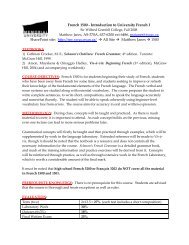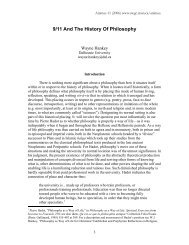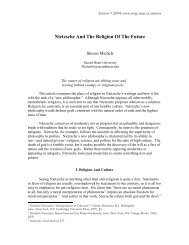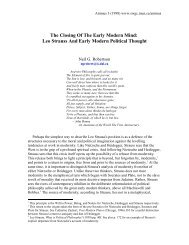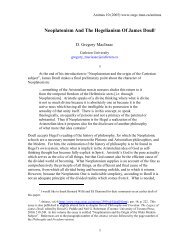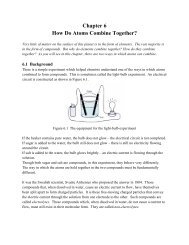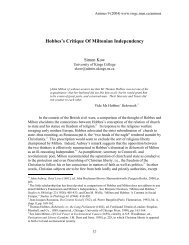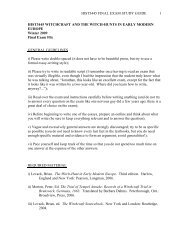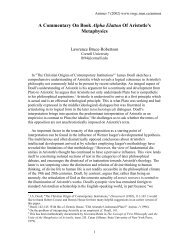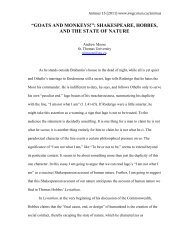Create successful ePaper yourself
Turn your PDF publications into a flip-book with our unique Google optimized e-Paper software.
Chapter 8<br />
<strong>Answers</strong> to Questions<br />
1. (a) formula mass Na 2 S = (2 × 23.0 u) + (1 × 32.1 u) = 78.1 u<br />
(b) formula mass CaCO 3 = (1 × 40.1 u) + (1 × 12.0 u) + (3 × 16.0 u) = 100.1 u<br />
(c) formula mass Al(NO 3 ) 3 = (1 × 27.0 u) + (3 × 14.0 u) + (9 × 16.0 u) = 213.0 u<br />
2. (a) molecular mass NO 2 = (1 × 14.0 u) + (2 × 16.0 u) = 46.0 u<br />
(b) molecular mass P 4 O 6 = (4 × 31.0 u) + (6 × 16.0 u) = 220.0 u<br />
(c) molecular mass IF 7 = (1 × 126.9 u) + (7 × 19.0 u) = 259.9 u<br />
3. (a) molar mass SnI 4 = (1 × 118.7 g) + (4 × 126.9 g) = 626.3 g∙mol −1<br />
(b) molar mass PF 5 = (1 × 31.0 g) + (5 × 19.0 g) = 126.0 g∙mol −1<br />
(c) molar mass (NH 4 ) 2 SO 4 = (2 × 14.0 g) + (8 × 1.01 g) + (1 × 32.1 g) + (4 × 16.0 g)<br />
= 132.1 g∙mol −1<br />
4. (a) molar mass SF 6 = (1 × 32.1 g) + (6 × 19.0 g) = 146.1 g∙mol −1<br />
(b) molar mass SnCl 2 ∙2H 2 O = (1 × 118.7 g) + (2 × 35.5 g) + (4 × 1.01 g) + (2 × 16.0 g)<br />
= 225.6 g∙mol −1<br />
(c) molar mass Mg 3 (PO 4 ) 2 = (3 × 24.3 g) + (2 × 31.0 g) + (8 × 16.0 g) = 262.9 g∙mol −1<br />
5. (a)<br />
First, calculate the molar mass of PbCl 2 = (1 × 207.2 g) + (2 × 35.5 g) = 278.1 g∙mol −1<br />
Strategy<br />
Relationship<br />
mass PbCl 2 → mol PbCl 2 1 mol ≡ 278.1 g PbCl 2<br />
(b)
First, calculate the molar mass of SiO 2 = (1 × 28.1 g) + (2 × 16.0 g) = 60.1 g∙mol −1<br />
Strategy<br />
Relationship<br />
mass SiO 2 → mol CaI 2 1 mol ≡ 293.9 g SiO 2<br />
6. (a)<br />
First, calculate the molar mass of MgSO 4 = (1 × 24.3 g) + (1 × 32.1 g) + (4 × 16.0 g)<br />
= 120.4 g∙mol −1<br />
Strategy<br />
Relationship<br />
mass(kg) MgSO 4 → mass(g) MgSO 4 1 kg = 1000 g<br />
mass MgSO 4 → mol MgSO 4 1 mol ≡ 120.4 g MgSO 4<br />
(b)<br />
First, calculate the molar mass of Ag 2 S = (2 × 107.9 g) + (1 × 32.1 g) = 247.9 g∙mol −1<br />
Strategy<br />
Relationship<br />
mass(mg) Ag 2 S → mass(g) Ag 2 S 1 kg = 1000 g<br />
mass Ag 2 S → mol Ag 2 S 1 mol ≡ 247.9 g Ag 2 S<br />
7. (a)<br />
First, calculate the molar mass of BaBr 2 = (1 × 137.3 g) + (2 × 79.9 g) = 297.1 g∙mol −1<br />
Strategy<br />
Relationship
Mol of BaBr 2 → mass BaBr 2 1 mol ≡ 297.1 g BaBr 2<br />
(b)<br />
First, calculate the molar mass of Cu 2 O = (2 × 63.5 g) + (1 × 16.0 g) = 143.0 g∙mol −1<br />
Strategy<br />
Mol of Cu 2 O → mass Cu 2 O<br />
Relationship<br />
1 mol ≡ 132.1 g Cu 2 O<br />
8. (a)<br />
First, calculate the molar mass of PbCrO 4 = (1 × 207.2 g) + (1 × 52.0 g) + (4 × 16.0 g)<br />
= 323.2 g∙mol −1<br />
Strategy<br />
Relationship<br />
Mol of PbCrO 4 → mass PbCrO 4 1 mol ≡ 323.2 g PbCrO 4<br />
(b)<br />
First, calculate the molar mass of NCl 3 = (1 × 14.0 g) + (3 × 35.5 g) = 120.4 g∙mol −1<br />
Strategy<br />
Relationship<br />
Mol of NCl 3 → mass NCl 3 1 mol ≡ 132.1 g NCl 3<br />
9.<br />
Strategy<br />
Relationship<br />
Mol of N 2 O 3 → # of molecules N 2 O 3 1 mol ≡ 6.02×10 23 molecules<br />
# of molecules N 2 O 3 → # of atoms O 1 molecule N 2 O 3 ≡ 3 atom O
10.<br />
Strategy<br />
Relationship<br />
Mol of Fe 2 O 3 → # of formula units Fe 2 O 3 1 mol ≡ 6.02×10 23 formula units<br />
# of formula units Fe 2 O 3 → # of ions O 2− 1 formula unit Fe 2 O 3 ≡ 3 ions O 2−<br />
11.<br />
First, calculate the molar mass of SF 4 = (1 × 32.1 g) + (4 × 19.0 g) = 108.1 g∙mol −1<br />
Strategy<br />
Relationship<br />
Mass of SF 4 → mol SF 4 1 mol ≡ 108.1 g SF 4<br />
Mol of SF 4 → # of molecules SF 4 1 mol ≡ 6.02×10 23 molecules<br />
# of molecules SF 4 → # of atoms F 1 molecule SF 4 ≡ 4 atom F
12.<br />
First, calculate the molar mass of PbF 4 = (1 × 207.2 g) + (4 × 19.0 g) = 283.2 g∙mol −1<br />
Strategy<br />
Relationship<br />
Mass of PbF 4 → mol PbF 4 1 mol ≡ 283.2 g PbF 4<br />
Mol of PbF 4 → # of formula units PbF 4 1 mol ≡ 6.02×10 23 formula units<br />
# of formula units PbF 4 → # of ions F − 1 formula unit PbF 4 ≡ 4 ions F −<br />
13.<br />
First, calculate the molar mass of PCl 3 = (1 × 31.0 g) + (3 × 35.5) = 137.5 g∙mol −1<br />
14.<br />
First, calculate the molar mass of CaCO 3 = (1 × 40.1 g) + (1 × 12.0 g) + (3 × 16.0 g)<br />
= 100.1 g∙mol −1<br />
15.<br />
Assume 100.0 g of compound. This will contain 48.0 g of zinc and 52.0 g of chlorine.
Rounding to the nearest whole number of 1:2, gives the empirical formula of ZnCl 2 .<br />
16.<br />
Assume 100.0 g of compound. This will contain 19.0 g of tin and 81.0 g of iodine.<br />
Rounding to the nearest whole number of 1:4, gives the empirical formula of SnI 4 .<br />
17.<br />
Percent O = 100.0% – 62.6% − 8.5% = 28.9%<br />
Assume 100.0 g of compound. This will contain 62.6 g of lead; 8.5 g of nitrogen; and<br />
28.9 g of oxygen.<br />
Rounding to the nearest whole number of 1:2:6, gives the empirical formula of PbN 2 O 6 .
18.<br />
Percent O = 100.0% – 36.5% − 25.4% = 38.1%<br />
Assume 100.0 g of compound. This will contain 36.5 g of sodium; 25.4 g of sulfur; and<br />
38.1 g of oxygen.<br />
Rounding to the nearest whole number of 2:1:3, gives the empirical formula of Na 2 SO 3 .<br />
19.<br />
Assume 100.0 g of compound. This will contain 38.7 g of carbon; 9.8 g of hydrogen; and<br />
51.5 g of oxygen.<br />
Rounding to the nearest whole number of 1:3:1, gives the empirical formula of CH 3 O.<br />
The molecular formula will be some multiple of this: (CH 3 O) n . To find n, the ratio of the<br />
molar mass (62.1 g) and the empirical formula mass<br />
(1 × 12.0 g + 3 × 1.01 g + 1 × 16.0 g = 31.0 g) is found. The value n is always an integer.
The molecular formula is (CH 3 O) 2 or more correctly, C 2 H 6 O 2<br />
20.<br />
Assume 100.0 g of compound. This will contain 48.6 g of carbon; 8.2 g of hydrogen; and<br />
43.2 g of oxygen.<br />
To obtain integers, each number must be multiplied by two: 3.00 C : 6.0 H : 2 O<br />
Rounding to the nearest whole number of 3:6:2, gives the empirical formula of C 3 H 6 O 2 .<br />
The molecular formula will be some multiple of this: (C 3 H 6 O 2 ) n . To find n, the ratio of<br />
the molar mass (74.1 g) and the empirical formula mass<br />
(3 × 12.0 g + 6 × 1.01 g + 2 × 16.0 g = 74.1 g) is found. The value n is always an integer.<br />
The molecular formula is (C 3 H 6 O 2 ) 1 or more correctly, C 3 H 6 O 2<br />
21.<br />
First, the mass of oxygen can be found by subtraction = (4.626 g – 4.306 g) = 0.320 g<br />
Then the empirical formula type solution is employed.
Empirical formula is Ag 2 O.<br />
22.<br />
First, the mass of oxygen can be found by subtraction = (7.59 g – 3.76 g) = 3.83 g<br />
Then the empirical formula type solution is employed.<br />
To obtain integers, each number must be multiplied by two: 2 Mn : 6.98 O<br />
Rounding to the nearest whole number of 2:7, gives the empirical formula of Mn 2 O 7 .<br />
23.<br />
First, the mass of water is needed = (7.52 g – 5.54 g) = 1.98 g<br />
Then the empirical formula type solution is employed.<br />
Empirical formula is FePO 4 ∙3H 2 O<br />
24.<br />
The empirical formula type solution is employed.
Empirical formula is CaCl 2 ∙6H 2 O



